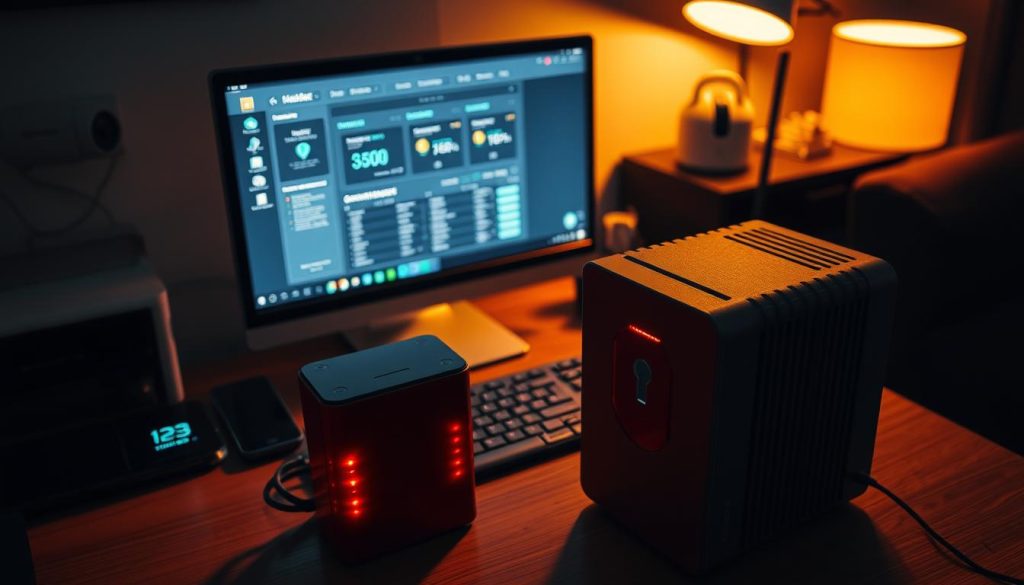The Internet of Things (IoT) has changed how we live and work. It has also brought new cybersecurity threats, like IoT botnets.
IoT botnets are groups of hacked IoT devices. They are used for bad things, like DDoS attacks and spreading malware. Knowing about IoT botnets helps keep your devices and data protection safe.
As you explore the IoT world, it’s key to know about IoT botnet risks. Taking steps to protect your devices is important.
Key Takeaways
- IoT botnets are networks of compromised devices used for malicious activities.
- Understanding IoT botnets is crucial for device and data protection.
- Securing your devices is essential to prevent them from joining an IoT botnet.
- Cybersecurity threats associated with IoT botnets are on the rise.
- Proactive measures can help protect your devices and data.
Understanding IoT and Its Background
As we rely more on connected devices, knowing about IoT is key. The Internet of Things (IoT) is a network of devices, vehicles, and appliances. They have sensors, software, and internet connectivity, allowing them to share data.
Definition of IoT
The Internet of Things (IoT) includes many devices, like smart home gadgets and wearables. They connect through the internet. This lets them talk to each other and their surroundings, making our lives more automated.
Growth of IoT Devices
The number of IoT devices is skyrocketing. The global IoT market is expected to keep growing fast. This is thanks to tech advancements and cheaper connected devices.
| Year | Estimated Number of IoT Devices (in billions) |
|---|---|
| 2020 | 15 |
| 2021 | 18 |
| 2022 | 22 |
| 2023 | 25 |
| 2024 | 30 |
Importance of IoT Security
As IoT devices grow, so does the need for strong security. Unsecured devices can be hacked, leading to data breaches. It’s vital to protect these devices to keep user data safe.
To boost IoT security, use strong passwords, update device firmware, and set up secure networks.
What are IoT Botnets?
IoT botnets are networks of hacked devices used for bad things. They are made when hackers take over many IoT devices. These devices then do bad things when told to by hackers.
Definition of IoT Botnets
An IoT botnet is a group of connected devices like cameras and routers. Hackers use malware to control these devices. They use these botnets for Distributed Denial-of-Service (DDoS) attacks, spreading malware, or stealing data.
How IoT Botnets Operate
IoT botnets start when malware infects devices. This can happen through weak passwords or unpatched vulnerabilities. Once infected, devices join the botnet and follow hacker commands.
These botnets can grow very big, with hundreds of thousands of devices. Here’s how they work:
- Infection: Malware gets into devices, often through weak spots or passwords.
- Control: Infected devices connect to a server, waiting for orders.
- Execution: The botnet does what it’s told, like launching a DDoS attack.
Real-World Examples
The Mirai botnet is a big example. It launched huge DDoS attacks in 2016. It infected over 600,000 devices by using default passwords.
Other botnets like Reaper and Hajime also use IoT vulnerabilities. They show why we need to protect our devices and find malware fast.
Key Threats Posed by IoT Botnets
IoT devices are getting more connected, which means the risk of IoT botnets is growing. These botnets can harm your data and devices. They can lead to serious problems.
Performance Issues
IoT botnets can slow down your devices. This makes them less useful. For example, a botnet attack on a smart home device might make it slow to respond.
- Reduced device responsiveness
- Increased latency in data transmission
- Potential for device crashes
Data Privacy Risks
IoT botnets also threaten your privacy. They can steal important information like passwords and financial details. This can cause identity theft and financial loss.
- Unauthorized access to personal data
- Data breaches through compromised devices
- Potential for data misuse by malicious actors
Impact on Businesses
IoT botnets can hurt businesses a lot. They can cause data breaches, financial losses, and damage to reputation. Businesses use IoT devices for many things, and an attack can stop these operations.
To fight these threats, it’s key to use strong monitoring and data protection. Update your devices regularly, use strong passwords, and keep your network secure.
The Evolution of Botnets in the IoT Era
The IoT era has seen a big change in botnet evolution, thanks to new tech. With more connected devices, the risk of botnet attacks grows. It’s key to understand this change to fight back effectively.
Historical Context
Botnets have been around since the early 2000s. They started with DDoS attacks and spam. The advent of IoT has made them more powerful.
At first, botnets were simple, using one vulnerability. But as security got better, botnet makers had to adapt and innovate.
Advances in Technology
New tech has helped botnets grow. IoT devices are now more complex and connected, making them vulnerable. Weak passwords on these devices are a common entry point for malware.

IoT devices have also given botnet operators a huge pool of bots. This lets them launch bigger attacks, like massive DDoS attacks.
Recent Trends
IoT botnets are getting smarter and targeting specific areas. For example, the Mirai botnet in 2016 used weak IoT passwords for huge DDoS attacks.
Now, IoT botnets are also used for cryptocurrency mining and other money-making activities. As IoT keeps changing, we’ll see new botnet uses.
How IoT Botnets Are Discovered
It’s key to know how IoT botnets are found to boost online security and fight cybersecurity threats. With more IoT devices in our lives, finding and handling IoT botnets gets harder.
Common Detection Methods
There are a few main ways to spot IoT botnets. One is to watch network traffic for odd patterns or changes that might show a botnet is there. Another is to check system behavior for signs of trouble, like sudden changes in how a device works or strange processes running.
- Monitoring network traffic for suspicious activity
- Analyzing system logs for signs of unauthorized access
- Using malware detection tools to identify known threats
Challenges in Identification
Even with these methods, finding IoT botnets is still tough. The wide range of IoT devices and the lack of common security rules make it hard to detect them. Also, many IoT devices don’t have good logging or monitoring, making it even tougher to spot problems.
To beat these hurdles, it’s vital to have strong cybersecurity measures. This includes keeping IoT devices up to date with the latest security patches and using top-notch threat detection tools.
Vulnerabilities of IoT Devices
IoT devices are becoming more common, but they’re also attracting hackers. This is a big problem for both people and companies. The main issue is that these devices often don’t have strong security.
Lack of Security Standards
IoT devices lack a common security standard. This is unlike regular computers, which have well-established security rules. This makes IoT devices easier targets for cyber attacks.
Key issues due to lack of security standards include:
- Inconsistent security protocols across different devices
- Insufficient encryption methods
- Inadequate secure coding practices
Default Credentials
Many IoT devices come with default usernames and passwords. These are often not changed by users. This makes it easy for hackers to get into devices.
The risks associated with default credentials are significant:
- Attackers can use default credentials to log in to devices
- Devices can be easily compromised and added to botnets
- Data privacy is compromised as attackers access sensitive information
Insecure Network Configurations
IoT devices often connect to networks that aren’t secure. This makes it simple for hackers to get to the data or take control of devices.
The following table highlights common insecure network configurations and their potential impacts:
| Insecure Configuration | Potential Impact |
|---|---|
| Open ports and services | Unauthorized access to devices and data |
| Weak Wi-Fi passwords | Network intrusion and data theft |
| Outdated firmware | Exploitation of known vulnerabilities |

To protect against these threats, it’s crucial to take strong security steps. This includes changing default passwords, keeping firmware up to date, and making sure networks are secure.
The Role of Malware in IoT Botnets
IoT botnets heavily rely on malware. This malware compromises IoT devices, turning them into bots. Attackers can then control these bots remotely.
Types of Malware Involved
IoT botnets use different types of malware. These include Trojans, worms, and ransomware. Each type has its own way of infecting devices. For example, Trojans look like normal software, while worms spread on their own.
Delivery Mechanisms
Malware reaches IoT devices in various ways. It often exploits vulnerabilities or uses weak passwords. Keeping devices updated and using strong passwords helps prevent infections.
Notable Malware Examples
Some malware has made big headlines. The Mirai malware used default passwords to create a huge botnet. Another example is Bashlite, known for its role in DDoS attacks.
Knowing about these malware types is key to stopping them. By staying updated on cybersecurity threats, you can keep your IoT devices safe.
Prevention Strategies for Home Users
As a home user, you are key in keeping your devices safe from IoT botnets. A few simple steps can greatly improve your IoT devices’ security and protect your network.
Change Default Passwords
Changing your IoT devices’ default passwords is a simple yet effective way to secure them. Many devices come with easy-to-find default passwords that hackers love. By changing these, you make it tough for unauthorized access.
Tips for creating strong passwords:
- Use a mix of letters, numbers, and special characters.
- Avoid using your name or birthdate, as they are easy to guess.
- Use a password manager to keep your passwords safe.
Update Firmware Regularly
Keeping your IoT devices’ firmware updated is essential for their security. Updates often fix vulnerabilities, making it harder for hackers. Regular updates can greatly lower the risk of your devices being compromised.
Best practices for updating firmware:
- Enable automatic updates if you can.
- Check for updates manually if auto-updates aren’t available.
- Always follow the manufacturer’s update instructions.
Use Stronger Authentication Methods
Using stronger authentication, like two-factor authentication (2FA), adds extra security to your IoT devices. 2FA requires a password and another verification step, making it harder for hackers to get in.
Benefits of 2FA:
- It adds an extra security layer beyond passwords.
- It lowers the risk of unauthorized access even if passwords are stolen.
- It helps protect sensitive data on your devices.

By following these steps, you can greatly improve your IoT devices’ security and lower the risk of them joining an IoT botnet. Being proactive and informed is crucial for a secure home network.
Best Practices for Businesses
To fight IoT botnet risks, businesses need a strong security plan. It’s key to protect your IoT devices to keep your network safe and data secure.
Implement Network Segmentation
Network segmentation breaks your network into smaller parts. This makes it hard for malware to spread. It limits damage from a breach. You can use VLANs or firewalls to keep IoT devices separate from important parts of your network.
Regular Security Audits
Regular security checks are vital to find weak spots in your IoT devices and network. These audits should include:
- Reviewing device settings and firmware versions
- Looking for default or weak passwords
- Checking network segmentation and access controls
These audits help spot issues early. This keeps your IoT devices and data safe.
| Security Audit Tasks | Frequency | Responsible Team |
|---|---|---|
| Review device configurations | Quarterly | IT Security |
| Check for default passwords | Bi-annually | IT Security |
| Assess network segmentation | Annually | Network Operations |
Employee Training
Teaching employees about IoT security is crucial. Training them on the dangers of IoT devices and cybersecurity best practices can stop many attacks. Topics should include:
- Spotting phishing attempts
- Using strong passwords and authentication
- Reporting any odd activity
By following these steps, businesses can lower the risk of IoT device attacks. This improves overall security and data protection.
The Importance of Firewalls and Security Software
Protecting your IoT devices from cyber threats is crucial. A strong security strategy includes firewalls and security software. With more IoT devices, the attack surface grows. So, it’s vital to have effective security measures.
Types of Security Software for IoT
There are many types of security software for IoT devices. These include:
- Antivirus software: It detects and removes malware from your devices.
- Anti-malware software: This software focuses on detecting and fighting malware threats.
- Intrusion Detection Systems (IDS): These systems watch network traffic for unauthorized access or malicious activity.

Benefits of Firewalls
Firewalls are key in IoT security. They control network traffic based on security rules. The benefits of using firewalls are:
- Blocking unauthorized access: Firewalls stop hackers from getting to your IoT devices.
- Controlling network traffic: Firewalls manage data flow, protecting against malware and cyber threats.
Configuration Recommendations
To get the most from your firewalls and security software, proper setup is essential. Here are some tips:
- Regularly update your security software: Keep your antivirus and anti-malware software current to fight new threats.
- Configure your firewall correctly: Set your firewall to block unwanted connections. Also, consider setting rules for specific IoT devices.
- Use strong passwords: Use strong, unique passwords for your IoT devices and security software to prevent unauthorized access.
Understanding the role of firewalls and security software is key. By following these steps, you can greatly improve your IoT devices’ security. This helps protect against cyber threats.
Monitoring Your Network for Threats
It’s key to watch your network traffic and system behavior to spot threats. By keeping an eye on your network, you can find oddities that might mean an IoT botnet is present.
Tools for Monitoring
There are many tools to help you watch your network for threats. These include:
- Network Intrusion Detection Systems (NIDS): These systems check network traffic for unauthorized access or bad activity.
- Security Information and Event Management (SIEM) systems: SIEM systems gather and analyze log data from different sources to find security threats.
- Network Monitoring Software: This software watches network traffic in real-time, helping you spot and act on threats fast.
Signs of Compromised Devices
Knowing the signs of compromised IoT devices is important. These signs include:
- Unusual network activity: Seeing odd network patterns might mean your device is talking to a botnet.
- Device malfunction: If your IoT devices act strangely or don’t work right, they might be hacked.
- Increased data usage: A big jump in data use could mean your device is sending data to a bad server.
By staying alert and using the right tools, you can keep your network safe. This way, you can protect your IoT devices from botnet attacks.
Responding to an IoT Botnet Attack
If you think an IoT botnet attack is happening, act fast. These attacks can harm your online safety a lot. Knowing how to react is key to keeping your data safe.
Steps to Take Immediately
When you spot a possible IoT botnet attack, start by isolating the affected devices. This stops the malware from spreading. Make sure to:
- Disconnect affected devices from the internet.
- Find and isolate the attack source if you can.
- Use your incident response plan, if you have one.
Reporting the Incident
Telling someone about the attack is very important. It helps get help and stops others from getting attacked. You should:
- Tell your Internet Service Provider (ISP) about the attack.
- Inform local authorities or cybersecurity agencies, as needed.
- Share details with online communities or forums.
Recovering Affected Devices
Getting devices back to normal means removing the malware and making them safe again. This includes:
- Doing a deep analysis to see how bad the infection is.
- Updating or patching devices to fix weak spots.
- Changing passwords and avoiding default ones.
It’s also important to make your online security better after an attack. This means using stronger passwords, updating regularly, and checking for security issues.
Legal and Ethical Considerations
The IoT world is growing fast, making cybersecurity more critical than ever. This growth affects data protection and internet safety greatly. Keeping IoT devices safe is a big deal, not just for tech reasons but also for legal and ethical ones.
Regulations on IoT Security
Now, governments and rules makers are focusing on IoT security. They’re making laws to make sure devices are secure. For example, the California IoT Law says devices must have good security. The EU’s Cybersecurity Act wants to boost IoT security in Europe.
Ethical Responsibilities of Manufacturers
Manufacturers must make sure their devices are safe for users. They should design devices with security in mind, update them often, and be open about their security. This helps keep users safe and makes the IoT world safer for everyone.
Here are some ways manufacturers can improve IoT security:
- Use strong encryption
- Fix security issues quickly
- Store data safely
Following these steps can greatly lower the chance of devices being hacked and used for bad things.
Future of IoT Security
IoT security is on the verge of a big change. This is thanks to new technologies and growing threats. As more devices connect, we need stronger security than ever.
Emerging Technologies
Artificial Intelligence (AI) and Machine Learning (ML) are making IoT devices safer. These technologies help devices learn from past attacks. This way, they can better defend against future threats.
Blockchain technology is also changing the game for IoT security. It makes data safer by storing it in many places. This makes it harder for hackers to get to.
Predictions for Future Threats
IoT devices will keep attracting hackers. We might see more Distributed Denial-of-Service (DDoS) attacks. These attacks use many devices to crash systems.
IoT systems are getting more complex. This could lead to new weaknesses. For example, problems with how devices talk to each other or keep data safe.
To fight these threats, we need to keep up with IoT security news. We should use new tech and best practices to protect our devices.
Conclusion: Securing Your IoT Environment
IoT botnets are a big threat to both home users and businesses. It’s important to understand the risks and take action to protect your data and cybersecurity.
Key Takeaways
Know the weaknesses of IoT devices and how malware works in botnets. To keep your devices safe, change default passwords, update firmware often, and use strong authentication. These steps can greatly lower the chance of your devices being part of a botnet.
Staying Ahead of Emerging Threats
To keep your IoT environment safe, stay updated on new threats and cybersecurity advancements. This way, you can protect your devices and data. For home users, taking these steps helps keep your personal data safe and makes the digital world more secure for everyone.

